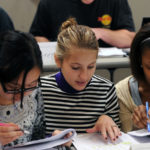By CHRISTOPHER S. RUGABER
AP Economics Writer
WASHINGTON (AP) _ U.S. economic growth should accelerate in the second quarter and remain healthy for the rest of this year, according to a forecast by a group of U.S. business economists. Still, growth for the full year will likely come in lower than they previously estimated.
Job growth should remain steady and consumer spending will also likely pick up, a survey by the National Association of Business Economists said Monday. The survey of 47 economists from companies, trade associations and academia was conducted from May 8 to May 21.
The survey also found that economists increasingly agree that the Federal Reserve will end its bond purchase program by the end of this year.
That’s partly because economists are optimistic about growth for the rest of this year: They expect it will jump to 3.5 percent in the second quarter and remain above 3 percent for the rest of the year.
But the pickup comes after harsh winter weather caused the nation’s gross domestic product to contract 1 percent in the first three months of the year, much worse than analysts had expected. GDP is the broadest measure of an economy’s output.
That weak first quarter reading has caused many economists to lower their expectations for 2014 as a whole. The NABE survey found that economists now project growth will be just 2.5 percent this year, down from a forecast of 2.8 percent in March.
The new forecast is still slightly above the annual average growth rate of about 2.2 percent since the recession ended in June 2009 and up from 1.9 percent in 2013. But stronger growth is needed to accelerate hiring and boost wage growth, which has been weak by historical standards.
The NABE’s survey is slightly more pessimistic than the Federal Reserve’s most recent projections, released in March. The Fed expects growth will be between 2.8 percent and 3 percent this year. The Fed may lower its growth outlook for this year when it releases its next forecasts later this month because of the first quarter’s contraction.
Economists are nearing a consensus about the timing of the Federal Reserve’s next moves. Nearly three-quarters expect the Fed will end its bond purchase program in the final three months of this year, the NABE survey found. That’s up from the 57 percent who said so three months ago.
The Fed is purchasing Treasury securities and mortgage-backed bonds in an effort to lower long-term interest rates to encourage more borrowing and spending. It has been steadily paring back the program, from $85 billion a month last year to $45 billion in May.
In addition, 86 percent of economists forecast that the Fed will raise the benchmark short-term interest rate it controls for the first time in 2015. In March, just 53 percent said 2015, while one-third said this year and 15 percent said a rate hike wouldn’t occur until 2016.
The NABE survey found that the economists are more optimistic about hiring. They project that employers will add 209,000 jobs a month this year. That’s up from their March forecast of 188,000.
So far this year, hiring has been a little bit better: it has averaged 214,000 a month from January through May.
More jobs means more people earning paychecks, and that can boost spending. Economists are more optimistic about consumer spending this year, which they estimate will grow at a 2.9 percent pace. That would be the highest level since 2006.









